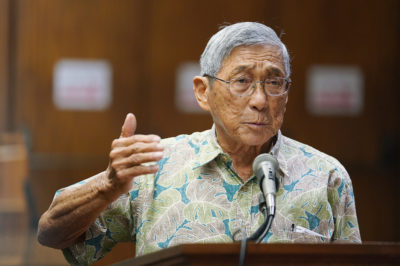Above Photo: Anti-TMT demonstrators conduct ceremonies to welcome the sun at the base of Mauna Kea on July 15. Cory Lum/Civil Beat
UPDATED: The governor finally visits the mountain on Day 9 of massive protests against the Thirty Meter Telescope construction.
Hawaii Gov. David Ige wants Hawaii County Mayor Harry Kim to take the lead on negotiating with opponents of the planned Thirty Meter Telescope who are engaged in a massive protest to prevent its construction on Mauna Kea, a mountain they consider sacred.
The governor issued a statement Tuesday morning on the ninth day of protests before visiting activists camping on the mountain in the late afternoon. Hundreds of people were gathered peacefully at Puʻu Huluhulu across from Mauna Kea Access Road to oppose the project.
The governor was greeted with lei and hugs by activists, Hawaii News Now reported around 5:45 p.m.
Earlier, Kahoʻokahi Kanuha, one of the activists’ leaders, told news media that he’s encouraged by Ige’s decision to pass control to Kim.
“He lives in this community. He knows this community,” Kanuha said, adding that Kim, a Hilo resident, had visited the activists’ camp three times. Ige flew to Hawaii Island last week but did not go to Puʻu Huluhulu.
Meanwhile, a three-judge panel of the First Circuit Court ruled Tueday that Paul Neves must be allowed to ascend to the summit of Mauna Kea to conduct his cultural practice. Neves had sued to challenge Ige’s emergency proclamation allowing the state to more strictly control access to the mountain.
The judges allowed the rest of the emergency proclamation to stay in place, and exception is for Neves alone.
While there wasn’t a temporary halt of the emergency proclamation, attorney David Kopper of the Native Hawaiian Legal Corporation still has 10 days to file for an injunction that could put a stop to Ige’s proclamation.
In another court ruling Tuesday, a judge in Hilo denied protesters’ request for a temporary restraining order to stop TMT construction.

Regarding Ige’s statement about Kim, Kanuha said he was pleased that the governor referred to activists as “protectors” rather than “protesters.” They call themselves kiaʻi, the Hawaiian word for guard.
“For the first time he has acknowledged us as protectors of Mauna Kea,” Kanuha said. “We’re encouraged and filled with hope by the governor’s new language.”
Kanuha still wants daily access for kupuna to conduct cultural practices on the mountain in exchange for allowing observatory staff to go up. The entire staffs of the existing Mauna Kea observatories evacuated the mountain last week amid concerns over inconsistent access.
Activists have allowed support and emergency staff to pass their blockade on Mauna Kea Access Road but won’t permit observatory staff to pass. They have requested one vehicle of cultural practitioners be allowed drive up to the summit daily but state authorities, who have a checkpoint a few yards up the Mauna Kea Access Road from the protesters’ own checkpoint, have denied the request for a week.
Ige is under pressure from both supporters and opponents of the TMT to take decisive action — either clear the road for construction, which was supposed to begin last week, or give up on the telescope being built in Hawaii. The state made dozens of arrests last week but didn’t remove all the activists blocking the road. Since then, opposition to the project has spawned protests across Hawaii and elsewhere in the U.S.
Ige said in his Tuesday morning statement that he’s asking Kim to “coordinate both county and state efforts to peacefully attempt to reach common ground with the protectors of Maunakea and the broader community.”
“Mayor Kim is closest to the situation and the impacts are greatest on the island he leads,” Ige said. He said both of them share the goal of achieving a peaceful resolution that satisfies most people in the community.
“I support the vision he has widely articulated for Maunakea as a beacon of hope and discovery for the world that brings us together rather than divides us,” Ige said. “And we both understand that the issues underlying what is taking place today are far deeper than TMT or Maunakea. They are about righting the wrongs done to the Hawaiian people going back more than a century.”
Ige said he will continue to work with Kim to determine the next steps for the project.
Kim did not immediately respond to a request for comment on Ige’s statement. The mayor’s staff said he was talking to the governor at the time.
“Things are happening fast and it’s a fluid situation,” said Dan Meisenzhal, spokesman of the University of Hawaii, when reached about the governor’s statement. “We’re just being made aware of that statement as well.”


